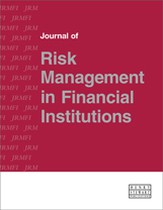A mixed approach to risk aggregation using hierarchical copulas
Abstract
Risk aggregation is the roll-up of low-level risks or sub-risks to higher levels. Risk management for banks or insurance institutions involves risk measurement and risk control at the individual risk level, including market risk, credit risk and operational risks, and also the aggregated risk of these individual risks. To determine the total enterprise risk for a financial institution, all risks must be aggregated. An accurate estimation of the total risk is necessary to control and manage the risk. Risk aggregation is a challenge because it requires an aggregated view of various levels of reporting risks, with differences in metrics and differences in data sources, etc. It is especially complex to aggregate risk when the joint dependence between all the individual risks has to be specified. Indeed, a common view of the dependence between all individual risks may not be available. It is well known that the copula approach provides a way of isolating the marginal behaviour of individual risks from the description of their dependence structure. Further, allowing a mixed approach to specify copula dependence between individual risks allows that risk dependence to be specified step by step. That is, decomposed in partial sums, which are more easily understood. Mixed copula aggregation does not fully specify the joint distribution but rather provides the minimum amount of information to determine the aggregate risk. This approach allows users to specify different dependence characteristics as is needed and the model complexity can be adjusted to the complexity required by the aggregation.
The full article is available to subscribers to the journal.
Author's Biography
Jimmy Skoglund is Principal Product Manager at SAS. He has more than 15 years’ experience developing and implementing risk methodologies, both at SAS and previously with banks. Jimmy has worked in various areas of risk management, including market, credit and liquidity risk. He holds a PhD from Stockholm School of Economics and is a regular contributor to publications in risk and finance journals and has also published a comprehensive financial risk management book with Wiley Finance.
Wei Chen is a Director of Stress Testing Solution at SAS Institute Inc. He has more than 15 years’ industry experience in risk analytics and technology for both banking and insurance. At SAS he has managed the research and development of solutions and business consulting in market, credit and liquidity risk management. Wei has published frequently in risk journals. He received his PhD, his primary research area being in financial econometric modelling, from the University of Iowa. He is a certified Financial Risk Manager (FRM).
Citation
Skoglund, Jimmy, Erdman, Donald and Chen, Wei (2013, March 1). A mixed approach to risk aggregation using hierarchical copulas. In the Journal of Risk Management in Financial Institutions, Volume 6, Issue 2. https://doi.org/10.69554/JRTO3381.Publications LLP
